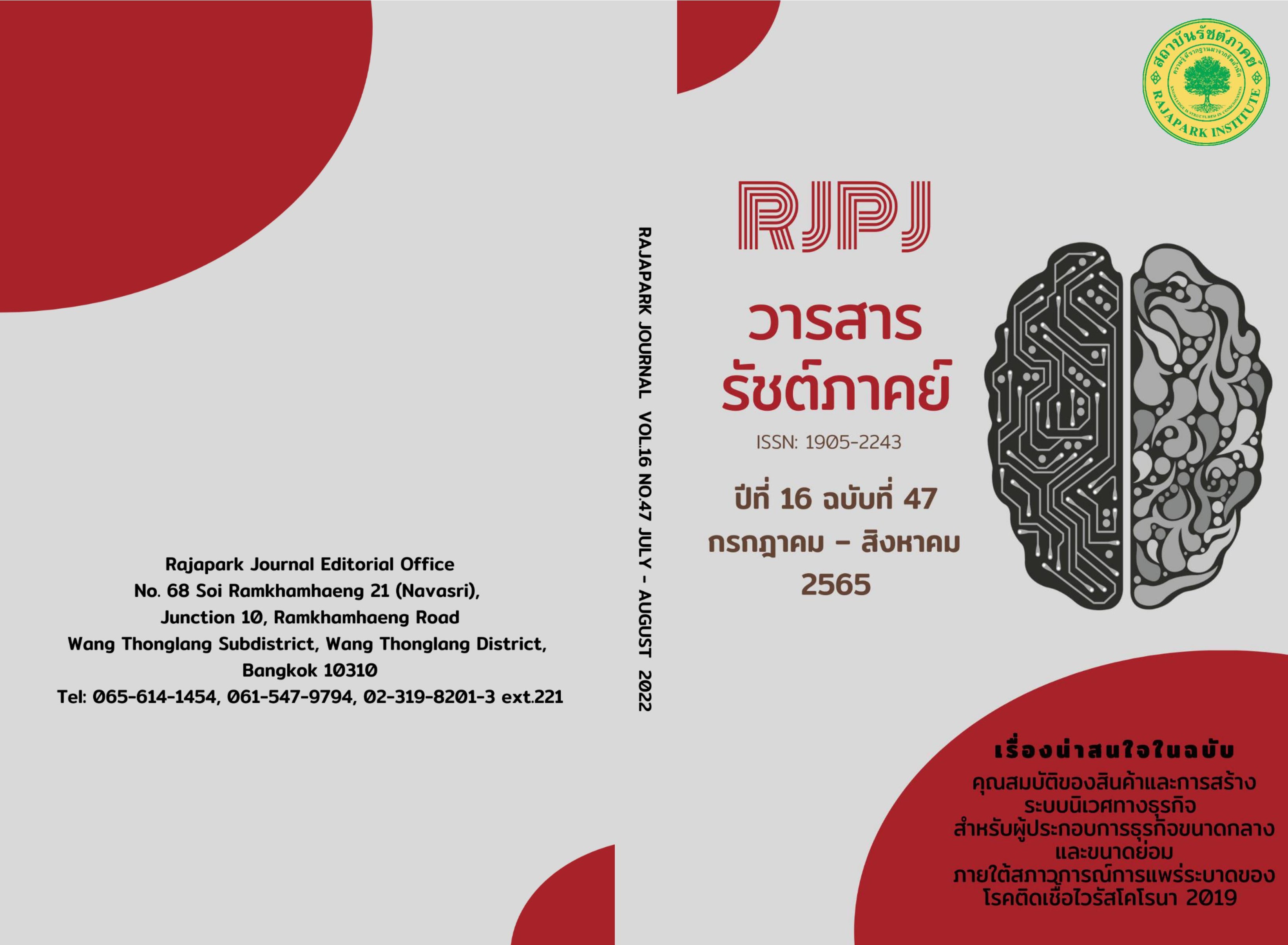Developing the Online Relationship Marketing Models in Thai Mobile Banking Services using Exploratory Factor Analysis
Main Article Content
Abstract
This research article aimed to develop an online relationship marketing in mobile banking services that can fit in Thailand. The researcher employed quantitative research. The sample was 433 mobile banking users in Thailand. Data was collected through an online survey. The analysis of the overall harmony index of the model according to Thai people. After the researcher adjusted the model, it was found that the model was consistent with the empirical data. The coefficient of harmony of the 6 indices that passed the accepted criterion was χ2 = 149.313, χ2/d.f. = 1.990, RMSEA = 0.048, CFI = 0.978, TLI = 0.970, and SRMR = 0.036. The research found that online relationship marketing has a statistically significant direct effect on relationship quality, customer engagement, and loyalty. Relationship quality has a statistically significant direct effect on customer engagement and loyalty. This research article can be utilized by mobile banking service providers, agencies that make policies, and related departments and service businesses to ensure they develop and improve their service systems.
Article Details

This work is licensed under a Creative Commons Attribution-NonCommercial-NoDerivatives 4.0 International License.
Views and opinions appearing in the Journal it is the responsibility of the author of the article, and does not constitute the view and responsibility of the editorial team.
References
Anderson, R. E., & Srinivasan, S. S. (2003). E-Satisfaction and E-Loyalty: A Contingency Framework. Psychology & Marketing, 20(2), 123-138.
Bank of Thailand. (2021). Bangkok FinTech Fair 2021. Bank of Thailand. https://www.bot.or.th/Thai/PaymentSystems/FinTech/Documents/BFF2021Event%20summary%20TH.pdf
Berry, L.L. (1983). “Relationship Marketing”, in Berry, L.L., Shostack, G.L. and Upah, G.D. (Eds), Emerging Perspectives of Services Marketing. American Marketing Association.
Boateng, S. L. (2018). Online Relationship Marketing and Customer Loyalty: A Signaling Theory Perspective. International Journal of Bank, 37(1), 226-240.
Brun, I., Rajaobelina, L., & Ricard, L. (2016). Online Relationship Quality: Testing an Integrative and Comprehensive Model in the Banking Industry. Journal of Relationship Marketing, 15(4), 219-246.
Busalim, A., Hussin, A. R. C., & Iahad, N. (2019). Factors Influencing Customer Engagement in Social Commerce Websites: A Systematic Literature Review. Journal of Theoretical and Applied Electronic Commerce Research, 14(2), 1-14.
Cochran, W. G. (1977). Sampling Techniques (3rd ed). John Wiley and Sons.
Chan, T. K. H., Zheng, X., Cheung, C. M. K., Lee, M. K. O. & Lee, Z. W. Y. (2014). Antecedents and Consequences of Customer Engagement in Online Brand Communities. Journal of Marketing Analytics, 2(2), 81-97.
Davis, F. D., Bagozzi, R. P., & Warshaw, P. R. (1989). User Acceptance of Computer Technology: A Comparison of Two Theoretical Models. Science, 35(8), 982-1003.
Grönroos, C. (1994). From Marketing Mix to Relationship Marketing: Towards a Paradigm Shift in Marketing. Management Decision, 32(2), 4-20.
Hassenzahl, M., & Tractinsky, N. (2006). User Experience–A Research Agenda. Behaviour & Information Technology, 25(2), 91-97. http://dx.doi.org/10.1080/01449290500330331
Hair, J. F., Ringle, C. M., & Sarstedt, M. (2011). PLS-SEM: Indeed a Silver Bullet. The Journal of Marketing Theory and Practice, 19(2), 139-152. https://doi.org/10.2753/MTP1069-6679190202
Henning-Thurau, T., Gwinner, K. P., Walsh, G., & Gremler, D. D. (2002). Understanding Relationship Marketing Outcomes: An Integration of Relational Benefits and Relationship Quality. Journal of Service Research, 4(3), 230-247.
Hollebeek, L. D. (2011). Demystifying Customer Brand Engagement: Exploring the Loyalty Nexus. Journal of Marketing Management, 27(7-8), 785-807. DOI:10.1080/0267257X. 2010.500132
Hu, Y., Pratt, C. B., Adamolekun, W., & Ogedengbe, A. R. (2016). Communicating Development’ – A Cultural Shift: Emerging Discourses on Entrepreneurial Development and Poverty Reduction by Nigeria’s Banking and Microfinance Sectors. Critical Arts, 30(5), 709-727.
https://doi.org/10.1080/02560046.2016.1262439
Kasikorn Research Center. (2021, May 7). The Third COVID-19 Outbreak Boosts Growth of Mobile Banking and e-Wallets. Kasikorn Research Center. https://www.kasikornresearch.com/th/analysis/k-econ/financial/Pages/Mobile-Banking-z3219.aspx
Keller, K. L. (1993). Conceptualizing, Measuring, and Managing Customer-Based Brand Equity. Journal of Marketing, 57(1), 1-22. https://doi.org/10.2307/1252054
Kousheshi, M. R., Aali, S., Zendeh, A. R. B., & Iranzadeh, S. (2019). The Antecedents and Consequences of Online Relationship Quality in Internet Purchases. Journal of Islamic Marketing, 11(1), 161-178. DOI:10.1108/JIMA-01-2019-0002
Lawshe, C. H. (1975). A Quantitative Approach to Content Validity. Personnel Psychology, 28(4), 563-575. https://doi.org/10.1111/j.1744-6570.1975.tb01393.x
Monferrer, D., Moliner, M. A., & Estrada, M. (2019). Increasing Customer Loyalty Through Customer Engagement in the Retail Banking Industry. Spanish Journal of Marketing-ESIC, 23(3), 461-484. https://doi.org/10.1108/SJME-07-2019-0042
Quach, S., & Thaichon, P. (2017). From Connoisseur Luxury to Mass Luxury: Value Co-creation and Co-destruction in the Online Environment. Journal of Business Research, 81, 163-172.
Samaha, S. A., Beck, J. T., & Palmatier, R.W. (2014). The Role of Culture in International Relationship Marketing. Journal of Marketing, 78(5), 78-98.
Siam Commercial Bank. (2021). Digital Payment Transformation. https://www.scbeic.com/th/detail/product/7924
Steinhoff, L., Arli, D., Weaven, S., & Kozlenkova, I. V. (2019). Online Relationship Marketing. Journal of the Academy of Marketing Science, 47(3), 369-393.
Thaichon, P., Liyanaarachchi, G., Quach, S., Weaven, S., & Bu, Y. (2019). Online Relationship Marketing: Evolution and Theoretical Insights into Online Relationship Marketing. Marketing Intelligence & Planning, 38(6), 676-698.
Vishal, V., & Sonika, R. (2014). Drivers of Customers’ Switching Behaviour in Indian Banking Industry. International Journal of Bank Marketing, 32(4), 321-342.
Walsh, G., Hennig-Thurau, T., Sassenberg, K., & Bornemann, D. (2010). Does Relationship Quality Matter in E-services? A Comparison of Online and Offline Retailing. Journal of Retailing and Consumer Services, 17(2), 130-142. https://doi.org/10.1016/j.jretconser.2009.11.003
Wazid, M., Zeadally, S., & Das, A. K. (2019). Mobile Banking: Evolution and Threats: Malware Threats and Security Solutions. IEEE Consumer Electronics Magazine, 8(2), 56-60. DOI: 10.1109/MCE.2018.2881291
Wong, W. P. M., Lo, M. C., & Ramayah, T. (2014). The Effects of Technology Acceptance Factors on Customer e-Loyalty and e-Satisfaction in Malaysia. International Journal of Business & Society, 15(3), 477-502. http://www.ijbs.unimas.my/repository/pdf/Vol15-no3-paper7.pdf
Yadav, B. K., & Singh, A. (2014). Relationship Marketing Research (1983-2012): An Academic Literature Review and Classification. Int. J. Electronic Customer Relationship Management, 8(4), 221-250. DOI:10.1504/IJECRM.2014.067511
Zhang, J. Q., Craciun, G., & Shin, D. W. (2010). When does Electronic Word-of-Mouth Matter? A Study of Consumer Product Reviews. Journal of Business Research, 63(12), 1336-1341. https://EconPapers.repec.org/RePEc:eee:jbrese:v:63:y:2010:i:12:p:1336-1341


